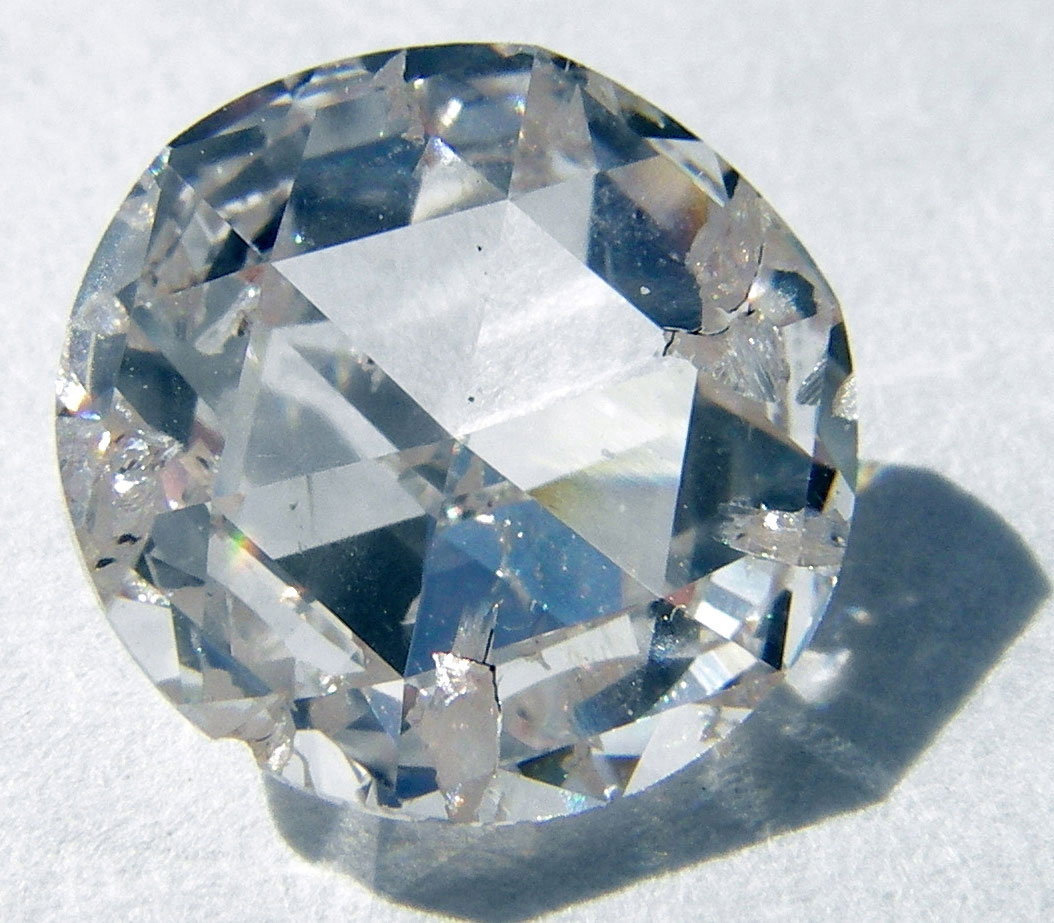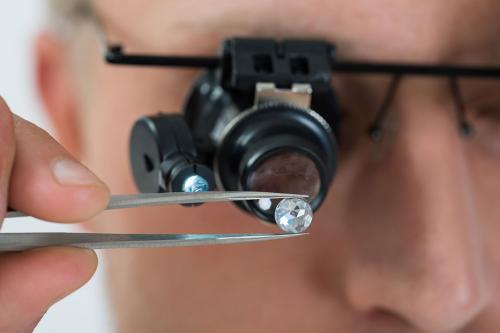Eighty years after De Beers changed the world with its ‘Diamonds are forever’ ad campaign, the diamond industry is losing its sparkle. In 1940, just 10% of first-time brides in the USA received a diamond engagement ring. By 1990, that had grown to 80%, and this success was mirrored in De Beers campaigns around the world. But even then, its cartel control of the market had begun to fracture. At its peak in the 1980s, De Beers controlled 90% of the world’s diamond sales. By late 2015, this had dropped to 31%.
At its eighth diamond sales event of 2019 in Botswana, De Beers was finding increasing difficulty with controlling the market. Where it had formerly held the power to hand ‘sightholder’ buyers a bag of diamonds and dictate the quantity and price of the purchase, it could no longer do so. Sales in 2019 were 39% lower than the year before.
This decline may or may not be related to the growing trade in laboratory-grown diamonds. In 2016, Leonardo DiCaprio (star of the movie ‘Blood Diamond’) was a high-profile investor in a $100 million capital raising for Diamond Factory, which is reported to be producing 1000 carats per month.
At that time, De Beers was one of six participants in the Diamond Producers Association (DPA), which fought a rear-guard ‘Real is Rare’ campaign to have lab-grown diamonds labelled as ‘synthetic’, and banning the term ‘cultured diamond’. Regardless, in July 2018 the Federal Trade Commission revised its ‘Guides for the Jewelry, Precious Metals, and Pewter Industries’, acknowledging that the lab-grown gems have the same chemical and physical attributes as the mined stones, and removing the DPA-preferred specification of ‘natural origin’ in the definition of a diamond.
In May 2018, De Beers did a huge about-face. Through its subsidiary, Lightbox, it began marketing its own lab-grown diamond jewellery – once again turning the industry on its head.
Of course, this development didn’t come from nowhere. General Electric first announced the production of lab-grown diamonds in February 1955, a milestone in work that had commenced early in World War 2.
GE’s method, termed high-pressure high-temperature (HPHT), uses pressures and temperatures in excess of 5 GPa and 1500°C. A carbon source is infused with a transition metal solvent (alloys of Fe, Ni, Co and Mn-C), where the metal melts and dissolves the carbon under conditions somewhat analogous to natural processes deep in the Earth, with carefully controlled cooling to grow a crystal from a natural seed diamond.
Pressure reactor designs vary, with the most common being the BARS apparatus, or ‘split sphere’. It can grow diamonds up to 10 carats in a cylindrical capsule as large as 25 millimetres, with six precisely aligned inner anvils of tungsten carbide forming the shape of a double pyramid. These are, in turn, placed inside a second set of anvils in the shape of two hemispheres, in an oil-filled donut-shaped housing that is heated to extreme temperatures. Thermal expansion of the oil exerts the force to produce diamond growth.
However, HPHT is more commonly used these days to modify natural diamonds, most particularly to remove nitrogen inclusions, and thereby lessen the (brown) colour and improve the clarity of the diamonds.
It is interesting to note that nanodiamonds have been found at meteorite crash sites, and one alternative method of creating diamonds is known as ‘detonation synthesis’. Given that this is sometimes an unanticipated consequence of military research, much of the work is shrouded in secrecy … but what we know seems impressive. It is reported that detonation nanodiamonds have been mass-produced in China, Russia and Belarus, the products being sold into the abrasives and coatings markets.
More practically, the other major method for growing diamonds is chemical vapour deposition (CVD), as used by De Beers at its new $94 million facility being constructed in Oregon, USA. In CVD, diamonds are grown layer by layer – potentially making much larger diamonds. Operating at much more benign pressures (even below atmospheric), methane or other carbon gases and hydrogen are heated to several hundred degrees Celsius.
The dominant CVD approach uses microwave plasma activation. The seed diamond lattice is stabilised using hydrogen atoms to terminate the carbon, which prevents rearrangement to graphitic carbon, with the temperature too low for spontaneous bulk rearrangement. Under the plasma conditions, surface CH radical sites sometimes react with carbon-containing radicals from the gas phase, resulting in carbon adsorption in a very complex series of equilibrium reactions (bit.ly/33P1LFS). In many cases, the resulting CVD diamonds are then further processed by HPHT enhancement treatments.
The resulting polished product is so similar to natural stones that they are indistinguishable to the eye. (Notably, uncut natural and lab-grown diamonds are easily distinguished by their shape and morphology.) De Beers has announced that its own diamonds will be laser-inscribed with a microscopic Lightbox logo (visible under magnification) for easy identification, but as this can’t be universally enforced across the many manufacturers of lab-grown diamonds, gemologists are turning to spectroscopic methods for gemstone identification.
The International Institute of Diamond Grading & Research (IIDGR) offers diamond grading services, as well as selling specialised instruments for the purpose. As a starting point, IIDGR’s DiamondSure instrument (~$12 500) is a simple-to-use FTIR device for screening synthetics and type II and IaB natural diamonds, for referral to further testing via DiamondView (~$50 000).
Requiring the services of a trained lab tech, DiamondView uses surface fluorescence with ultraviolet light to quickly indicate the difference between natural and lab-grown diamonds. According to IIDGR’s website (bit.ly/2PpUJSa): ‘The colour of the fluorescence, the fluorescence pattern and the absence or presence of phosphorescence will differ depending on the stones’ natural or synthetic origin. To aid user interpretation of blue fluorescing CVD synthetics, easy to change filters are provided, which enhance synthetic-specific features.’
Depending on colour, the automated melee testing (AMS2) machine may also be applied. It uses photoluminescence to rapidly process gemstones up to 0.2 carats by photoluminescence, to determine whether they are diamonds (natural or lab grown) or other synthetic minerals such as moissanite (see box p. 17).
From there, the most expensive and accurate IIDGR instrument is the DiamonPLus, which uses photoluminescence at cryogenic temperatures. These more extreme conditions make the instrument impractical for all but specialised facilities.
As a non-destructive test, photoluminescence typically uses laser excitation at a variety of wavelengths to distinguish between natural, treated and lab-grown diamonds. It is limited to detecting optically active defects in the diamonds, but most of the key defects are optically active. As an example, a pair of photoluminescence peaks around 736 nanometres indicates the presence of silicon impurities, which are characteristic of CVD diamonds. Other peaks occurring in natural diamond have been correlated to colour, type and geographic origin, giving power to the technique when used in combination with a library of spectra for known samples and sophisticated processing software.
Impurities in the crystal lattice commonly interrupt lattice structure, which modifies the vibration characteristics of nearby atoms. Under laser excitation, the defects show both electronic transition and vibronic variations known as ‘phonon sideband’. The noise generated by the phonon sideband must therefore be eliminated by cooling in liquid nitrogen (–196°C), to separate the purely electronic transition (the ‘zero-phonon line’).
As noted, the technique can also then distinguish treated natural diamonds from untreated. The brown colour of type IIa natural brown diamonds is thought to be caused by clusters of atom vacancies in the carbon lattice. HPHT treatment can yield atom rearrangement to remove the brown colour, which can change the ratio of specific excitation peaks.
However, much of the detail is kept secret to retard the efforts of companies conducting treatment to ‘fool’ the analysis. This ‘arms race’ of modification versus detection remains ongoing, and these days analysts recommend the application of a suite of methods and wavelengths to facilitate differentiation.
The key point is that as the differences become harder to detect, the differentiation between natural and lab-grown diamonds must surely become increasingly artificial and arbitrary.
Already, De Beers’ lab-grown diamonds are significantly cheaper than their natural counterpart, at just initially $800 per carat – and at a flat rate disunited from size. Over the nine months from their introduction in May 2018 to February 2019, De Beers CEO Bruce Cleaver was widely reported as noting a 60% decrease in the wholesale prices of lab-grown diamonds.
Cleaver went on to deny any link to a fall in the price of natural diamonds, but this remains to be verified, particularly in the light of the 2019 falls in De Beers’ sales. For now, the natural diamond market dominates sales – estimated at 60 million carats of gem-quality natural stone sales from 148 million carats mined, versus 2 million carats of gem-quality lab-grown diamonds. But the numbers are shifting. De Beers’ new Oregon facility will produce 500 000 carats annually from 2020
Over time, the trends must surely be in favour of the lab-grown variety. Consumer sentiment, particularly in the anticipated generation Z market, will be for ethically and environmentally sourced products. Technological progress will continue to lessen the differences. And the inevitable price reductions will open new markets beyond the gem trade.
The physical durability, thermal stability and optical properties of diamond makes it an ideal material for all sort of applications. By 2020, China is projected to produce more than 9 million kilometres of diamond cutting wire annually, and diamond is already useful for a wide range of cutting and abrasion tools. Now, new forms of CVD diamond allow for application to less obvious tools such as thermal detectors for downhole drilling in corrosive and abrasive fluids at 150–200°C. Low-friction diamond-coated ball bearings open up possibilities for all sorts of mechanical nanodevices.
With high refractive index, diamond lenses could yield lighter and thinner lenses in eyewear. For the millennials, scratch-resistant mobile phone screens might help preserve devices all the way through to the end of a contract.
The high Young’s modulus of diamond could make it a lighter and ‘stiffer’ alternative to aluminium in speakers. Monocrystalline diamond also has high thermal conductivity, and could potentially also substitute aluminium in microchip heat sinks, leading to the next step change in computing processor power.
The ability to produced ultra-high purity diamonds (particularly type II diamonds with low nitrogen impurity levels), together with the ability to control nitrogen, silicon and boron impurity levels and sites, have brought quantum computing one step closer. Each element sits adjacent to carbon on the periodic table, and controlled disruptions to the diamond lattice create specific optical and magnetic effects at these sites.
In recent articles in Science (bit.ly/2pkX5sy) and Nature Communications (https://go.nature.com/2QnCzmh), researchers have reported breakthroughs in the controlled use of nitrogen vacancies and silicon vacancies for the storage and transfer of quantum bits (known as qubits) via the superposition of electron spin states. The science gets complicated quickly, but the headline is that the use of artificial diamonds may bring quantum computing from cryogenic temperatures to far more practical ambient applications.
For the time being, De Beers seems to be trying to have it both ways, attempting to build market dominance in lab-grown diamonds, while trying to simultaneously continue the marketing spin for natural diamonds. Hence, de Beers’ $94 million investment in Oregon is still dwarfed by its 51% investment in the new $650 million Gahcho Kué mine in the Northwest Territories of Canada.
Cleaver stated that ‘Lightbox will transform the lab-grown diamond sector by offering consumers a lab-grown product they have told us they want but aren’t getting: affordable fashion jewellery that may not be forever, but is perfect for right now’.
If the lab-grown gems truly are chemically and physically the same as natural stones, then there is no reason to expect that the former won’t be just as durable. And as the non-renewable natural supplies inevitably dwindle, the laboratories may be able to ensure that we truly do have diamonds forever.





